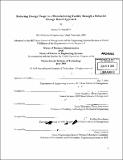Reducing energy usage in a manufacturing facility through a behavior change based approach
Author(s)
Norelli, Michael A., IV (Michael Anthony)
DownloadFull printable version (18.14Mb)
Other Contributors
Leaders for Global Operations Program.
Advisor
Sarah Slaughter and Leon Glicksman.
Terms of use
Metadata
Show full item recordAbstract
Many companies have developed energy reduction programs for their manufacturing facilities to reduce their operational costs while also decreasing their greenhouse gas emissions. The majority of these manufacturing facilities have made progress in reducing their energy usage through technology changes, such as purchasing more efficient lighting or replacing old chillers, however, these improvements are often capital intensive. The goal of this thesis is to explore the use of low cost employee behavior changes to help a manufacturing facility reduce its energy usage. The author conducted a six month case study at Raytheon's Integrated Air Defense Center (IADC) in which a new approach for achieving energy related employee behavior changes was implemented. The framework is unique to the author but builds upon lean manufacturing principles, social psychology research, and energy management fundamentals. The approach first raises awareness and engages employees, second, helps employees develop energy saving improvements, and lastly, creates a mechanism to sustain improvements and behavior changes moving forward. The benefits of using such an approach are greater employee engagement (the percentage of employees who participated in a voluntary energy reduction program rose from 38% to 78%), more energy saving ideas being implemented (over 60 employee generated energy saving improvements were implemented on the manufacturing floor), and, ultimately, a reduction in wasted energy. Additionally, a real-time feedback system was designed and installed that provided manufacturing employees with information on their cell's energy usage. This real-time feedback system was developed to help sustain improvements and further enable energy reductions through employee behavior changes. While specific tactics and tools of the applied approach may be unique to Raytheon's IADC facility, the strategy and insights can be universally applied.
Description
Thesis (M.B.A.)--Massachusetts Institute of Technology, Sloan School of Management; and, (S.M.)--Massachusetts Institute of Technology, Engineering Systems Division; in conjunction with the Leaders for Global Operations Program at MIT, 2010. Cataloged from PDF version of thesis. Includes bibliographical references (p. 98-100).
Date issued
2010Department
Leaders for Global Operations Program at MIT; Massachusetts Institute of Technology. Engineering Systems Division; Sloan School of ManagementPublisher
Massachusetts Institute of Technology
Keywords
Sloan School of Management., Engineering Systems Division., Leaders for Global Operations Program.